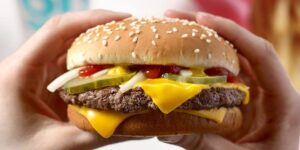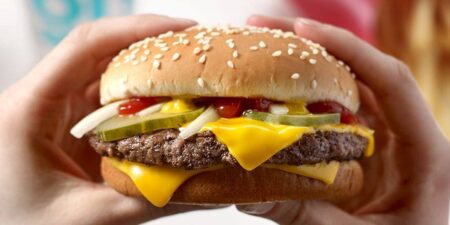- A 39-year-old man submitted an average day of eating to be reviewed for BI’s Nutrition Clinic.
- A nutritionist said that eating protein at breakfast would help with satiety and recovery.
- If you’d like to have your diet reviewed by an expert, fill out this form.
Justin, 39, submitted his eating routine to Business Insider’s Nutrition Clinic, where qualified dietitians and registered nutritionists offer advice on readers’ eating habits.
He told BI that his goals are to lose fat and weight overall to support his running goals. “I put on a few pounds during a recent injury,” Justin said.
Justin is a keen runner: A typical week is 60-80 miles of running across six days.
“I also do some basic strength training,” he said. “Planks, push-ups, and lunges — six days a week, and then some pull-ups, split squats, goblet squats, and step-ups a couple of times a week. Mostly bodyweight or light dumbbell stuff; nothing crazy with lifting, and I’m just starting to get more disciplined with it after an injury cycle.”
Registered nutritionist Rhiannon Lambert told BI that it’s great that Justin is so active and his high activity levels should keep him healthy and fit into later life.
Tip 1: Protein at breakfast
Justin runs first thing in the morning and then eats a half-cup of oatmeal with soy milk, pecans, and raisins. Sometimes he adds two hard-boiled eggs, he said.
He snacks later in the morning on a banana or a handful of cashews.
Lambert said it’s good to eat fiber-rich foods like oats, brown rice, beans, vegetables, and fruit: “These support digestion, help with satiety, and are beneficial for long-term gut health.”
Protein at every breakfast, whether eggs or yogurt, would also help with satiety and for Justin to recover from intense training, Lambert said.
Tip 2: Vary meals to boost gut health
For lunch, Justin often eats a bowl of brown rice with chicken and black beans, plus raw carrots, peppers, and cucumbers with hummus. Sometimes he has a banana, berries, or handful of nuts afterward, or cheese and gluten-free crackers, he said.
Lambert said that Justin’s meals like this lunch are well-balanced. They incorporate protein (chicken, eggs, beans), healthy fats (pecans, cashews, hummus), and carbohydrates (oats, rice, sweet potatoes), which are essential for maintaining energy.
While Justin is consuming lots of plant-based foods, he could try to increase the diversity by varying his meals.
“Research has found that people who consume 30 (or more) different plants a week, including fruits, vegetables, herbs, spices, legumes, pulses, etc., had a significantly more diverse and healthy gut microbiome than those who consumed less than 10 a week,” Lambert said.
Tip 3: Fiber-rich snacks with healthy fats
In the afternoon, Justin might snack on pretzels, granola, or a handful of Skittles or similar candy to “keep the sweet tooth at bay,” he said.
Snacks like pretzels, Skittles, or granola can be high in sugar and low in fiber which aren’t generally the best choices for satiety and energy, Lambert said.
She advises whole fruits paired with Greek yogurt. A small handful of nuts is another nutritious snack, paired with dark chocolate, Medjool dates, or dried fruit for sweetness.
“These all add both fiber and healthy fats, promoting better satiety and blood sugar control, ” Lambert said.
“This will all help to keep Justin feeling fuller for longer, avoid any energy crashes, and may also stop him overeating for the rest of the day.”
Tip 4: Fish and plant-based protein
As a dad to an eight-year-old and a five-year-old, Justin likes to make fun dinners, such as gluten-free spaghetti with ground chicken, tomato sauce, and Parmesan; grilled chicken with roasted sweet potatoes and steamed broccoli; homemade gluten-free pizza; or tacos with ground chicken or turkey.
After dinner, Justin might snack on a bowl of Cheerios with soy milk or a bag of popcorn to share, he said.
While chicken is a great lean source of protein, Lambert recommends variety.
“Including fish in his diet such as salmon would significantly increase his omega-3 intake which is essential for heart and eye health, or he could opt for plant-based options such as lentils or chickpeas which are rich in protein, but are also higher in fiber which is great for gut health,” Lambert said.
Tip 5: Portion sizes
Justin said he carries a 32-ounce water bottle with him all day and refills it regularly to stay hydrated. “I also have two to three cups of coffee per day and sometimes a glass of tea or diet soda,” he said.
“His focus on hydration is excellent, particularly since endurance athletes like Justin need to ensure they are consistently taking on enough fluids for training and recovery,” Lambert said.
Justin’s high activity levels require plenty of fuel for energy and recovery, but to lose fat he needs to be in a calorie deficit.
“Keeping an eye on portion sizes for foods like cheese, nuts, and oils could help Justin toward his weight goals,” Lambert said. “Monitoring how often post-dinner snacks like Cheerios or popcorn happen is important. These might be preventing him from achieving the calorie deficit needed for fat loss.”
Read the full article here
















